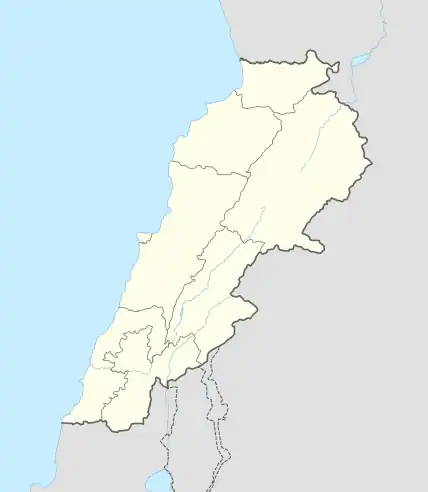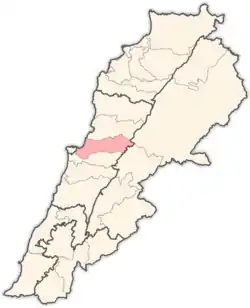Beit Chabab
بيت شباب | |
|---|---|
City | |
 Beit Chabab Location within Lebanon | |
| Coordinates: 33°55′38″N 35°40′21″E / 33.92722°N 35.67250°E | |
| Country | |
| Governorate | Mount Lebanon Governorate |
| District | Matn District |
| Highest elevation | 700 m (2,300 ft) |
| Lowest elevation | 600 m (2,000 ft) |
| Time zone | UTC+2 (EET) |
| • Summer (DST) | UTC+3 (EEST) |
| Dialing code | +961 4 |
Beit Chabab (Syriac: Bet Shebāba, Arabic: بيت شباب) is a mountain village 24 km north of Beirut in Lebanon.
Beit Chabeb is the site of Lebanon's one and only bell foundry.[1] The bells of Beit Chabab are sold to Christian communities in Lebanon and abroad to many foreign countries.[2] The village was completely embosomed in mulberry gardens at the turn of the century.[3] The Hôpital Beit Chabab - Collège du Liban pour les handicapés is located in the village[4]
History
Ottoman tax records indicate Beit Chabab had a population of 27 Muslim households (unspecified whether Sunni, Shia or Druze) in 1523, 32 Christian households in 1530, and 28 Christian households and two bachelors in 1543.[5]
The oldest church in Beit Chabab is Our Lady of the Forest, which was built in 1761.[1]
Etymology
The name "Beit Chabab" is widely believed to originate from the Arabic Bayt shabāb (meaning:"house of the young men"), but in reality it might have roots in Syriac. Anis Freiha argues in his Dictionary of the Names of Town and Villages in Lebanon that it comes from the Syriac Bet Shebāba meaning "house of the neighbor".
Bell Production
In Beit Chabeb, the ancient family tradition of bell making is still alive and well, thanks to the dedicated craftsmanship of Naffah Naffah. Single-handedly continuing this legacy, Naffah has inherited the knowledge and skills passed down from his ancestors, and he meticulously creates each bell with the same care and attention to detail that has been a hallmark of his family's craft for generations.
The craftsman, who is keeping the family tradition of bell-making alive in Beit Chabeb, has a personal connection to the history of this craft in the region. The Naffah name itself is tied to the bell-making heritage of his distant relative, Youssef Gabriel, who learned the trade as an apprentice to Russian bell-makers who had settled in Beit Chabeb in the early 1700s. When Gabriel made his first bell, the Russians were so impressed that they bestowed upon him the name "Naffah," which means "successful" or "accomplished" in Arabic. This name has been passed down through the generations of the family.
During a visit to his spacious workshop, he proudly shared this story, where he carefully tends to several casts and tables lined with tools. This family history is not just a personal one; it is also a significant part of Lebanon's cultural heritage, documented in the archives of the Holy Spirit University of Kaslik.
Beit Chabeb has become a renowned regional center for the bell-making trade, thanks to the skills of the Naffah family. Their handmade bells are highly sought-after and can be found in churches throughout Lebanon, as well as in Syria, Jordan, Egypt, Iraq, and Palestine.
Bell making is a meticulous and time-consuming art, but Naffah has managed to maintain the family business despite being the sole craftsman. He produces around 30 to 35 bells per year, but demand for his creations continues to rise. Naffah adheres to a rigorous schedule, working from 5 am to 5 pm every day, only taking a break to collect his children from school.
References
- 1 2 "Beit Chabab". Archived from the original on 2010-02-09. Retrieved 2010-02-07.
- ↑ Slivka, Rose. The Crafts of the Modern World, page 23
- ↑ The Entomologist's Record and Journal of variation, Volume 13
- ↑ "Centre Hospitalier Beit Chabab". Archived from the original on 2018-03-11. Retrieved 2018-03-11.
- ↑ Bakhit 1972, p. 277.
https://www.lebanontraveler.com/en/magazine/bellmakers-beit-chabeb/
Bibliography
- Bakhit, Muhammad Adnan Salamah (February 1972). The Ottoman Province of Damascus in the Sixteenth Century (PhD). School of Oriental and African Studies, University of London.
External links
- Beit Chabab - Chaouiyeh El Qnaytra, Localiban
